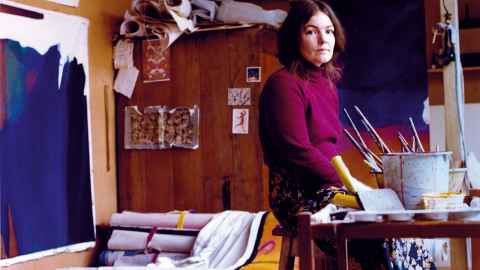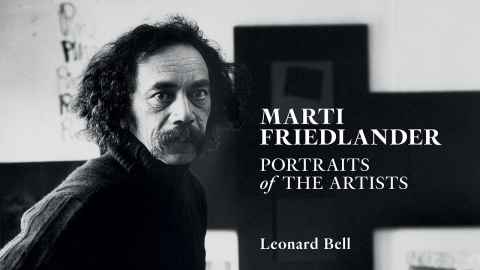Artists through the lens of Marti Friedlander
3 August 2020
A new book by Leonard Bell is an in-depth exploration of late photographer Marti Friedlander's portraits of artists.

‘A portrait: what could be more simple and more complex, more obvious and more profound,’ said Charles Baudelaire in 1859. That’s certainly true of photographer Marti Friedlander’s portraits, writes Leonard Bell.
Marti Friedlander (1928-2016) and I were very close friends. She was passionate, warm, free-thinking and critical, at times fierce (usually necessarily so), argumentative, sometimes infuriating. A friend described her as a ‘whirlwind’.
She was also one of New Zealand’s most outstanding photographers. Her career here spanned nearly 60 years and she worked in a variety of genre: documentary reportage, ‘street’ photography and portraiture, most notably. Her best-known portraits are probably those in Moko: Māori Tattooing in the 20th Century (1972, with later editions through to 2019). Moko features portraits of elderly Māori women. These portraits not only document their subjects with empathy but also helped Marti, a displaced and rather alienated young migrant from England, feel more at home here.
In New Zealand from 1958, she began photographing writers, artists and other creative people in 1959 and continued to do so to the end of her life. She probably produced more such portraits (around 400 different people) than any other quality professional photographer in the country. Yet those that have been published and exhibited make up only a minority of these portraits. The majority have not been seen publicly.
This book, while including some already-published portraits, features around 250 novel and compelling images of both well-known and now ‘forgotten’ or little-known artists, writers, craftspeople, actors et al. All of them, nevertheless, were prominent players in expanding and vitalising cultural fields in New Zealand in the 1960s, 1970s and later.
Marti’s first portrait of an artist or writer (Maurice Gee) was published in the periodical Landfall in 1960. This developed into a lifelong project. She wrote: “As I was travelling around the country, a priority was to seek out artists. It seemed to me that artists were struggling for recognition. I resolved to photograph as many of them as I could”.
Her photos, sharp-eyed and arresting in themselves, also offer a form of
socio-cultural history.
Her portraits appeared in many periodicals and newspapers, notably the New Zealand Listener, the New Zealand Herald, Marcia Russell’s proto-feminist Thursday, and Art New Zealand, as well as in exhibition catalogues and performance brochures, notably for Kees and Tine Hos’s New Vision Gallery, and books (many authors’ photos, for instance). Jim and Mary Barr’s New Zealand Artists A – M (1980) features her portraits.
Marti Friedlander: Portraits of the Artists shows and explores their range and diversity in terms of subject, style, format (single figure or groups, close-up to full-standing in their studios or work and performance environments), lighting, ‘look’, black and white and colour.
These photographs, sharp-eyed and arresting in themselves, also offer a form of socio-cultural history, full of invaluable insights into cultural milieus and social changes here from the 1960s on. A portrait, such as Marti’s, can have implications far beyond the depiction of its particular subject in her/himself. They are imaginative documents bearing complex relations to history and social actualities.
Her portraits also reveal brilliance in visualising qualities of individual personality and temperament. She caught seemingly conflictual states in the one face or situation. If ever a riposte to the stereotype that New Zealand was a land of ‘passionless people’ was needed, her photographs of creative people provide it. My book presents an array of independent-minded, unconventional and idiosyncratic people, most of whom, like Marti herself, went their own way irrespective of the ‘rules and regulations’ of mainstream society and officialdom. We need more people like them now.
Photo-historian William Main characterised Marti as the first photographer here ‘to take up the challenge of trying to tell you something about a person through the very nature of her photographs… [her work] put New Zealand portraiture on the map’ (1990).
Marti, who studied a couple of papers in Art History at the University of Auckland in 1976, was awarded an Honorary Doctorate by the University in 2016. That the archive of her prints, negatives and related documents held at the Auckland Art Gallery was recognised and honoured with its elevation to the UNESCO Memory of the World New Zealand Register in November 2018 – the first such in Australasia – is a measure of the status and substance of her oeuvre, in which her portraits of artists, writers et al. have primary places.
Associate Professor Leonard Bell teaches Art History in the School of Humanities.
His book Marti Friedlander: Portraits of the Artists (Auckland University Press) is out on 27 August, 2020. Hardback, $75
